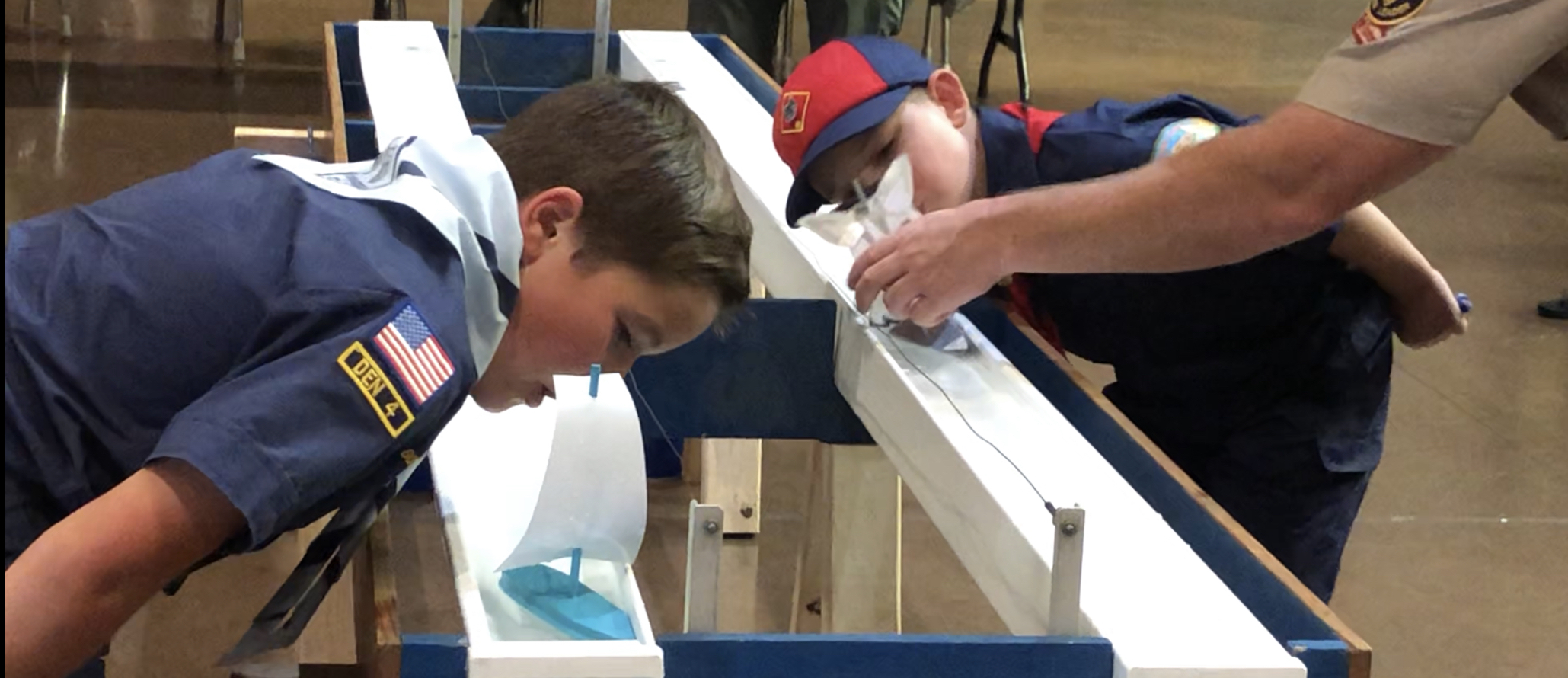Raingutter Regatta – Pack 1 Official Rules
Overview – “How does the Raingutter Regatta work?”
 The Raingutter Regatta is a boat race that is designed to be a parent-son project. Please feel free to give guidance and minimal assistance to your Scout as he builds his Raingutter Regatta boat, appropriate to his age. This is a chance for your son to be part of a team (he and you), and to enjoy the spirit of friendly competition with his peers. These “Official Raingutter Regatta Rules” are written to help you keep it simple and fun for your child, and to know what to expect when it comes time to race your boat.
The Raingutter Regatta is a boat race that is designed to be a parent-son project. Please feel free to give guidance and minimal assistance to your Scout as he builds his Raingutter Regatta boat, appropriate to his age. This is a chance for your son to be part of a team (he and you), and to enjoy the spirit of friendly competition with his peers. These “Official Raingutter Regatta Rules” are written to help you keep it simple and fun for your child, and to know what to expect when it comes time to race your boat.
A special note to all parents and scouts: Together, please read the sportsmanship section of this page. While everyone will be trying to win, it’s always a good idea to start out by remembering the Cub Scout Motto, “Do Your Best,” and some of the basic ideas behind good sportsmanship.
“If your scout is focusing on “winning” more than “building” than you have missed the boat. Ideally we want our scouts to have fun building this regatta boat with you (the parent), learning to assemble, follow directions, paint and to being prepared is the goal. Remind your scout that your goal is to ensure the regatta boat floats and finishes the race… Now that is a win.” – Chris Cooper, Cubmaster Pack 1
Ground Rules for Participation – “Who can race?”
Pack 1 leadership always tries to keep our activities family oriented, feel free to bring siblings, grandparents and proud Uncles/Aunts. Here are our participation guidelines:
- The race is open to all Lions, Tigers, Wolves, Bear, Webelos and AOLs Scouts registered to Pack 1 (Must be registered and on Pack 1 roster to participate as we have over 70+ scouts).
- Each scout may enter only one boat in the competition. They should have a significant level of participation in building their boat (designing, sanding, gluing, painting, decorating, etc.).
- The boat must have been built during the current program year (the school year in which the Regatta is held). Boats that have competed in a previous regatta are not permitted. The Pack provides a new kit to every registered Scout each year to make this easier.
Boat Specifications – “Are there boat building rules?”
To ensure that the race is as fair as possible, all boats must be made from the BSA Raingutter Regatta kits. However, the materials supplied in the kit can be modified or added to somewhat.
- You must use the parts supplied in the kit: trimaran hull, mast, sail, outriggers, and wood screws. The kit also includes assembly instructions and a sanding stick. The only other tool you will require to assemble the boat is a philips screwdriver.
- The boat must be no longer than 7 inches in length, nor shorter than 6 1/2 inches in length. This means you can shorten the outriggers somewhat when shaping them, but you cannot add to the length of the outriggers.
- The boat must be no wider than 3 3/8 inches–any wider and it may not fit in the gutter, or get hung up on the sides and go slow. The trimaran hull in the kit is only 3 1/4 inches in width. If your outriggers are flush with the sides of the trimaran hull, you’ll be fine.
- No keel or rudder may be attached to the boat.
- You may use the sail and mast that are included with the kit, or replace the sail and mast with a custom built “cup” sail. The mast for the sail must be no higher than 6 1/2 inches from the deck to the top of the mast. The sail may not extend above the top of the mast, and it should not extend wider than the width of the boat.
- Decorations/Additions: Objects such as sailors, pirates, cannons, etc. may be added. All such decorations must be firmly fastened to the boat, and may not be placed in such a manner as to exceed the boat dimensions as listed above. Your racing number must appear on both sides of the sail.
- Paint: DO NOT USE water based paints, they will run off the boat and make a mess in the water. Use spray paint or oil/acrylic paints. If you are not sure, please ask your Den Leader.
Boat Assembly Guidance – “How can I build a ‘winning’ boat?”
The following assembly guidelines (tips) are provided to help you get the best performance from your boat. They are not meant to be restrictive.
- Sail: Position the sail on the mast. About 3/4 inches from the top of the mast, either glue the sail to it, or attach securely with tape. Attach bottom of sail in a similar manner. The bottom edge of the sail needs to be about 1/2 inch above the deck of the boat. If the sail is too low, the corners rub against the gutter or dip in the water. If the sail is too high, the boat is top heavy and tends to tip over. A well secured sail makes the boat easier to handle in the water.
- Painting/Decorations: Sailboat body should be painted at least 24 hours before racing to allow sufficient time to dry. You may want to use Krylon spray paint — it dries to a sandable finish in about one minute on the balsa wood hulls. Do not use water soluble paints. Stickers, decals, and other objects may also be added to customize your boat. Use your imagination!
Inspection and Registration – “What must I do to enter my boat?”
Before the race begins, all participating “Captains” must check-in with their boats. Here are the pre-race check-in details:
- Before a boat may compete in the regatta, it is subject to a technical inspection, to verify that it meets the prescribed specifications. If a problem is noted, the Captain may be asked to correct it before the boat is registered.
- Number assigned to scout will be their boat race number and will follow them throughout their scouting.
- When the boat passes inspection, it is then registered along with the boat Captain’s name (the scout’s or sibling’s name).
- Typically, check-in of boats will handled just prior to the race.
Competition – “How will the race be run?”
Every race has to have rules, and ours is no exception. Here’s what to expect:
- Once all boats are registered (number/name/den), the competition brackets will be seeded by random order. This is a double elimination bracket, so each scout will race at least twice. Scouts will start by racing with other scouts from their same rank for Rank awards. Ribbons will be awarded in each Rank for places First thru Third and all runners up will receive medals.
- Each race heat will involve two equal lengths of raingutter (approximately 10-feet long) filled with water.
- The race heat begins once the official starter has placed the competing boats against the back wall of the gutter and commands the scouts to “GO!”
- On the starter’s command, the scouts will blow into the sail of their boat in order to advance them through the water. The boat can only be propelled by blowing into the sail by the scouts mouth. The use of straws and other aids of this type or nature is prohibited. Once the race has started, the scout CANNOT touch his boat with his hands, except to right a capsized boat.
- Pushing the boat forward is NOT allowed while righting a capsized or stuck boat by hand, nor is pushing by a scout’s face, lips, hat, nose or other body part that touches the boat. Pushing may disqualify the scout during that race heat. Any disputed heat may be rerun at the discretion of the judges.
- The first boat to reach the finish line (the opposite end of the gutter) is the winner of that heat. The finish line official(s) will have the final and only say in determining the winner. In the unlikely event of a tie, the racers will be given a chance to catch their breath, then that heat will be rerun.
- If a boat is damaged during a race (boat loses its mast, sail, or an outrigger) and can be repaired in a reasonable amount of time (a few minutes), the race may be run again at the discretion of the judges. Any non-functional decorations that fall off during competition will NOT be reattached during racing.
- Ungentlemanly or unsportsmanlike conduct by any participant, parent or spectator may be grounds for expulsion from the competition and/or the race area. No warnings! This is about the kids and we are here to support everyone win or lose.
Rewards and Recognition – “What can I take home?”
The most important values in Raingutter Regatta competition are parent/son participation, good sportsmanship and learning how to follow rules. The Awards Committee is responsible for recognizing and encouraging these qualities in addition to traditional racing awards. Here are the tangible awards that you may receive:
- Regatta Pins will be awarded to the first, second, and third place finishers in each rank.
- Boats from all ranks are eligible to be selected for appearance (static) awards. Judges will reward creativity and workmanship. Award categories include: Most Colorful, Really Radical, Most Realistic, Most Original, Most Scout Like, and Captain’s Choice.
Sportsmanship – “How should I act?”
Two things the Raingutter Regatta requires each participant to learn are 1) the craft skills necessary to build a boat and 2) the rules that must be followed. Even more important, though, is how we act and behave while participating in the Raingutter Regatta or any other group activity. This is called sportsmanship.
The first thing to remember about sportsmanship is that everyone’s skills are a little different. Your craft skills may be just developing, while someone else may be more experienced. Parents have different skill levels, too. Whether or not you feel that you have good boat-building or racing skills, remember, you and your friends are individuals first and racers second. This idea is often called having respect for others.
The second thing to remember is to follow the rules. Without rules, there would be no Raingutter Regatta.You will never know if you are really good at doing something unless you follow the rules. This is often called being honest.
The third thing to remember about good sportsmanship is that there are winners and losers in every competition. You accept this when you choose to compete. There may be times when you win and feel happy, and times when you lose and feel unhappy. Being a winner is easy, and losing is sometimes hard. If you win, you must not brag or gloat. If you lose, you must not feel jealous or bitter. To be a good sportsman, you must be able to say, “I did my best” and be satisfied with the results. You must also be able to appreciate and feel happy for someone else when he runs a good race or builds a neat boat.
Good Luck!
Any questions, please ask your Den Leader.

